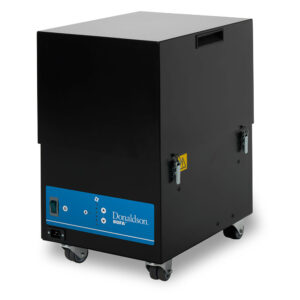There’s a certain ‘smell’ associated with ink printing and print finishing that can make for an unpleasant working environment.
These odors result from fumes and particles emitted by the inks, lacquers, adhesives, and solvents used in a wide range of printing processes, but the consequences of failure to remove the smell go way beyond employee comfort.
Without effective fume extraction technology, print shops could be exposing their operatives to airborne contaminants, which, as identified in Safety Data Sheets, possess the potential to be harmful to human health.
For print shop managers, this makes investment in filtration systems, such as those designed and manufactured by Donaldson BOFA, an important contributor to workplace environmental health strategies. In addition, the effective filtration of particles also helps to maintain a clean print operating area, which is vital for product quality and helps reduce unnecessary downtime.
New Print Inks and their Challenges
The print industry supply chain has responded to these emissions challenges in part by developing eco-ink and eco-solvent alternatives to ‘traditional’ ink composition. These tend to be less ‘smelly’ and are shown to be less flammable and generally better for the environment.

However, although these can be effective in helping to reduce workplace odor, a study of Safety Data Sheets is essential. For example, some eco-UV inks, often categorised as odorless, emit volatile organic compounds (VOCs) which should be filtered. A lot of focus is placed on the solvents in inks, but the pigments often consist of particles on the nanoscale that are released during printing.
So, despite these innovations, the challenge for health and safety managers remains not so much whether they need an extraction system to filter the vapors and mists generated by print operations, but which technology to select. This will depend on the scale and nature of their operations, particularly if this also includes laser cutting and engraving often associated with packaging.
As Darron Norrad, US Sales Manager for Donaldson BOFA, explains: “Whatever the scale, Donaldson BOFA’s filtration expertise can help match print processes to the right technological solution both to filter potentially harmful airborne contaminants from the workplace and to contribute to a clean operating environment.
“What’s critical for the print industry is that the extraction system meticulously balances air flow rates with a filtration architecture that delivers sufficient ‘dwell’ time capable of capturing particles and VOCs.”
Specific Advanced Carbon Filters for the Print Sector
Specifically for the print sector, Donaldson BOFA has developed advanced carbon filters, which integrate a HEPA filter with a chemical/gas filter. This innovative approach creates a more compact, cost-effective, and efficient solution to help filter fumes associated with a wide range of emissions, including ozone from UV applications and methyl ethyl ketone (MEK).
One of Donaldson BOFA’s most popular extraction systems for the print and print finishing industry is the PrintPRO Universal, which can be tailored to specific processes and printer types. Although portable and compact, the technology offers large capacity gas filters and provides VOC carbon bed saturation readings, which facilitate timely filter exchange and help maintain a lower odor working environment.
Find out more about Donaldson BOFA’s print industry solutions

